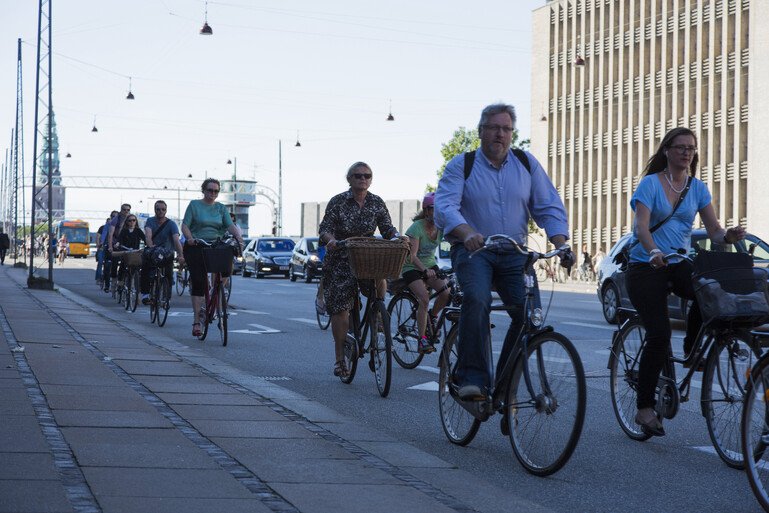
These cities are trying to save their residents from climate change
Cities are one of the biggest drivers of climate change. They could also be part of the solution.

A man rides a delivery bicycle next to the tram in Medellin, Colombia.
Joaquin Sarmiento / AFP via Getty Images
Cities – home to over half of the world’s population – currently account for more than 70% of global carbon dioxide emissions.
By 2050, city populations are expected to reach nearly seven billion. More people mean more waste to manage, more vehicles to run and a greater demand for food, water and energy.
As urban populations grow, they will be increasingly exposed to the health effects of climate change.
Around half a billion people live in urban coastal areas, putting them at greater risk of rising sea levels, and the health consequences of extreme urban heat will only worsen as the world warms. The risk is even higher in low- and middle-income countries where 90% of urban development is built as informal settlements near climate hazard-prone areas.
Cities are on the frontline of the climate crisis. But around the world, many are already leading the way with initiatives to reduce emissions and increase their resilience to climate change.
Medellin is prioritising green spaces
In Colombia’s second largest city, green corridors line the verges of 30 roads and waterways. Residents stroll through vibrant gardens or cycle beneath shady tree canopies where only tarmac and waste sites existed a few years ago.
These green spaces are thanks to the award-winning Green Corridor Project. The initiative launched in 2016 to address the severe urban heat problem Medellin was experiencing as a result of 50 years of rapid urban expansion.
Since completing the project, the city has seen a 2°C fall in average temperatures, air quality has improved, urban biodiversity has increased, and projections suggest the plants’ biomass will absorb 2000 tonnes of CO2 over the next 100 years.

People exercise at the Volador hill in Medellin, Colombia. The city of Medellin has been awarded and recognised for its urban planning of green corridors.
Joaquin Sarmiento / AFP via Getty Images
It is a model for the many benefits that nature-based climate adaptations can have on the health and wellbeing of urban populations.
Prioritising green space in urban planning could be key to cities around the world adapting to climate change. However, we need more research to better understand the benefits and limitations of climate adaptations like this.
Nairobi is rethinking waste management
Nairobi has a waste problem. Kenya's capital city produces nearly 2,500 tonnes of waste every day but only collects a third of that for disposal. The rest is often dumped illegally or burned, contributing to black carbon emissions and air pollution.
The sprawling city has one of the highest growth rates of any city in Africa, with more than half of its total population now living in informal settlements. The inadequate waste disposal systems can’t keep up.
This is having severe consequences on people’s health as the effects of climate change compound the issue, causing more flooding, infectious diseases and polluted waterways.

Shredded plastics are processed on a conveyor at a plastic recycling plant in Nairobi, Kenya.
James Wakibia / SOPA Images / LightRocket via Getty Images
Waste management is now one of Nairobi’s key priorities in its urban regeneration plan. The city will invest in everything from better collection and disposal infrastructure to cracking down on garbage cartels and illegal dumping areas.
Many of the initiatives not only improve waste management but also reduce the city’s emissions. One social enterprise, TakaTaka Solutions, now serves 120,000 households, recycling or composting up to 95% of the waste they collect. Meanwhile, two new waste-to-energy plants are in the works that will generate electricity by converting solid waste from the Dandora landfill into biogas and ethanol.
Actions to both mitigate and adapt are crucial to any city’s climate resilience plan.
Copenhagen is transforming city transport
The Danish capital is on track to become the world’s first carbon-neutral city by 2025. From renewable energy sources to innovative housing solutions, Copenhagen is leading the way in sustainable urban development.
One of its toughest challenges has been shifting away from car travel.
Transport accounts for about a fifth of the world’s energy consumption and road vehicles are responsible for most of that.
Copenhagen has set the ambitious goal for car use to make up just 25% of all travel in the city.
Pioneering projects like the world-renowned cycle superhighways and smart traffic signal systems, as well as increased vehicle taxes, have helped reduce car travel in the city to 31%.

Dense bicycle traffic in the city of Copenhagen, Denmark.
Fishman / ullstein bild via Getty Images
Now, almost half of Copenhageners commute to work and school by bike, and bicycles have outnumbered cars in the city since 2016. Increasing the number of cycling commuters is a very cost-effective way of reducing CO2 and NOx emissions, while also contributing to more physical activity and improving public health. The cycle highway project alone is expected to result in 40,000 fewer sick days per year in the city.
However, transportation still accounts for a third of the city’s carbon footprint. As Copenhagen continues to grow, and the transport systems come under increasing pressure, reaching their target will require even more innovation.
Research will provide better solutions
Cities in all corners of the world are already experiencing the effects of climate breakdown.
From storms, flooding and sea level rise to extreme heat, drought and landslides, cities must adapt now to protect their citizens from the current and future risks of extreme climate and weather events.
It is crucial that these adaptations go hand in hand with actions to significantly reduce the emissions cities contribute to the atmosphere. Without doing so, the health impacts will be even more devastating.
Like Medellin, Nairobi and Copenhagen, many cities are implementing ambitious plans, but more extensive policies must be achieved.
There is an urgent need for research to establish which policies will be most effective in cities around the world. So Wellcome is funding projects like Urban Health in Latin America (SALURBAL) and Complex Urban Systems for Sustainability and Health (CUSSH) to investigate the systems that connect urban development and population health, and deliver key research that can be translated into climate action.
We’re funding vital research into the impact climate change has on human health around the world, at national, regional and global levels. Explore our current funding call:
Advancing climate mitigation solutions with health co-benefits in low- and middle-income countries


